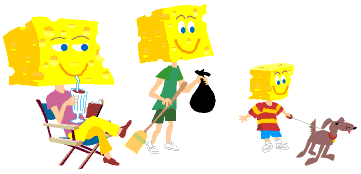

|
...
|
.
|
...
|

Recognize this universal problem?
When our three children were roughly seven, six and four and a half years old, we were always trying to settle disagreements over whose turn it was to do this or that, who enjoyed what "unfair" privileges, etc. Children of this age, when tired, hungry or simply in a snit, tend to bother each other, especially when safely buckled in the back seat of the family sedan. You parents have been there. This is where they send United Nations Negotiators for crisis training.
We happened to purchase a Volkswagen Minivan that particular year. The VW "bus" had two individual seats for driver and front passenger, a center seat wide enough for two people and a back seat broad enough for three - room for all with demilitarized zones keeping the kiddies apart. But who would sit where? What would be "fair"?
Our solution:
In what was probably our only moment of absolute genius, Susan and I came up with a plan we called The Big Cheese Arrangement. Rather than perpetuate an age-based pecking order (a little difficult to defend because our children were so close in age), we decided to rotate seniority, privileges, household responsibilities and seating assignments in the VW.

The Big Cheese would have the large middle seat all to himself or herself. He or she could decide who sat where at the dinner table. If a parent had an erand to run, the Big Cheese could tag along (alone or he/she could give permission to the other Cheeses to come, too). Wondering where to dine? Big Cheese picks. Can't decide which TV show to watch? Ask the Big Cheese. The Big Cheese enjoyed the most privileges and had the fewest household tasks.
The Middle Cheese was next in line to be Big Cheese, shared the back seat with The Little Cheese, and had more chores and fewer privileges than the Big Cheese.
The Little Cheese was at the bottom, had many chores and the fewest privileges. But The Little Cheese had hope. In a predictable number of days, he or she would be the Big Cheese. In our home, the positions changed monthly.
Within the first few months, there was a dramatic drop in the number of arguments. There was greater harmony in the household (not to mention the VW). Things weren't perfect, but a major source of conflict and discord had been completely neutralized. This worked for years and was only abandoned when the children outgrew the need for it.
Since then, we have described this plan to many parents. Those who tried it reported great success. Some have shortened the term to a week or two instead of a month. One father of four boys claims it saved his marriage, and recommends it to everyone he meets.
Benefits of The Big Cheese Arrangement:
- Taking turns as the Big Cheese builds self-esteem in young children
- Taking turns as Little Cheese builds empathy in older children
- Fixed time frame contributes to the development of a sense of the passing of time
- Knowing that your turn will come teaches patience
- Big Cheese Arrangement reminds children that there are pecking orders in life
- Little Cheese's few perks reminds children that life is not necessarily fair
- Situation encourages cooperative thinking, consensus-building and "deal making" among Cheeses
- Decision-making skills can be strengthened through age-appropriate choices offered by parents
- Parents retain their sanity and have more time to actually appreciate their children
Go to the next page to print a handy form that will help you get started.

About Learning
Related Topics:
 How Children Develop How Children Develop
 How People Learn Best How People Learn Best
 Ready To Learn Ready To Learn
 15 Ways to Help Your Child 15 Ways to Help Your Child
 The Big Cheese The Big Cheese
 Recommended Books Recommended Books
Return to top.
© 2015 Susan and Jerry Jindrich. All rights reserved.
|
|

